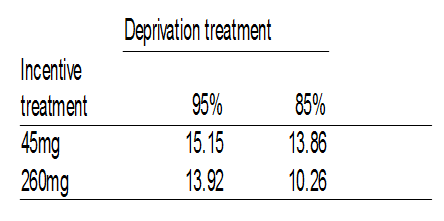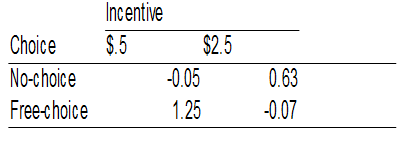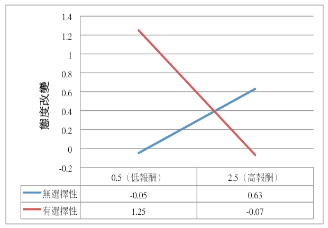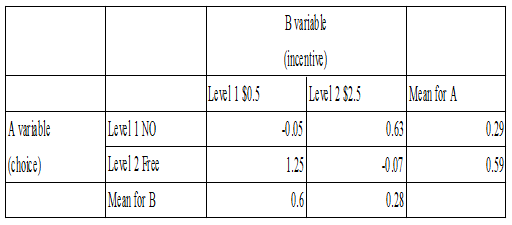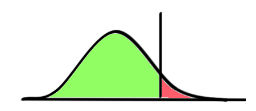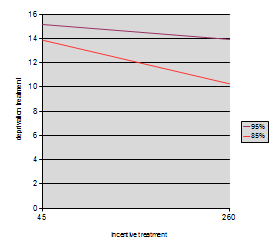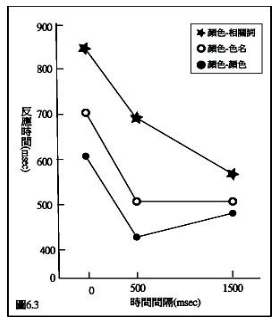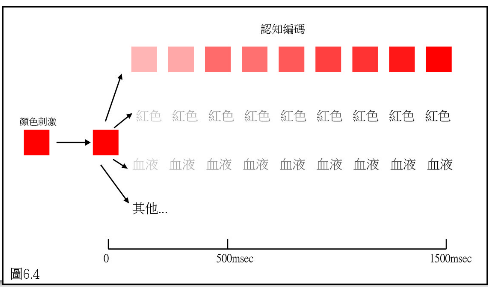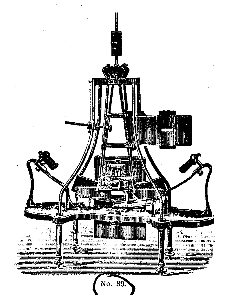心理實驗法第七講:factorial design
出自KMU Wiki
(修訂版本間差異)
| 在2013年3月10日 (日) 22:04所做的修訂版本 (編輯) Sakurai (對話 | 貢獻) (新頁面: == Factorial design == * 隨著時代進步,心理學的方法也進步 * 但心理學想問的問題本質沒有變 * 探討人類心理與行為背後存在的... * 以前所有問...) ←上一個 |
當前修訂版本 (2015年10月15日 (四) 09:28) (編輯) (撤銷) Sakurai (對話 | 貢獻) (→Mental chronometry) |
||
| (17個中途的修訂版本沒有顯示。) | |||
| 第22行: | 第22行: | ||
| *** ...... | *** ...... | ||
| *** | *** | ||
| - | *** | + | *** 不只一個原因影響 |
| - | + | ||
| === 多因子設計 === | === 多因子設計 === | ||
| * 多因子設計(factorial design) | * 多因子設計(factorial design) | ||
| - | ** 研究者在一個實驗裡同時觀察兩個或兩個以上的自變項對一個依變項影響的設計 | ||
| ** 例如 | ** 例如 | ||
| *** 父母育兒具敵意且過度干涉 -> 小孩退縮 | *** 父母育兒具敵意且過度干涉 -> 小孩退縮 | ||
| *** 若再加上忽略小孩 -> 小孩反社會 | *** 若再加上忽略小孩 -> 小孩反社會 | ||
| - | ** | + | ** 有些問題勢必兩項或以上的因素在一起才會發生 |
| - | + | ||
| - | + | ||
| - | === | + | === Case study '''1'''<br> === |
| ==== '''''Ehrenfreund and Badia (1962)<br>''''' ==== | ==== '''''Ehrenfreund and Badia (1962)<br>''''' ==== | ||
| 第46行: | 第42行: | ||
| *** 45mg / 260mg food pellet | *** 45mg / 260mg food pellet | ||
| * Dependent variable | * Dependent variable | ||
| - | ** | + | ** 5 feet跑道中間2 feet的速度 |
| * 控制 | * 控制 | ||
| ** Ad lib weight | ** Ad lib weight | ||
| *** 自然狀態下的體重 | *** 自然狀態下的體重 | ||
| - | *** | + | *** 因為每一隻老鼠的體重進食量不一,因此控制剝奪量本身對於個別動物的影響不同 |
| - | + | ||
| - | + | ||
| ** 量中間段的速度 | ** 量中間段的速度 | ||
| *** 因為起跑段與終點段的變化比較大 | *** 因為起跑段與終點段的變化比較大 | ||
| * 結果 | * 結果 | ||
| - | ** | + | ** 表6.1 |
| + | [[Image:6-1.PNG]] | ||
| - | {| width="200" cellspacing="1" cellpadding="1" border="1" summary="Chapter 4 case study 1" | ||
| - | |+ table 4-1 | ||
| - | |- | ||
| - | | Incentive treatment | ||
| - | | colspan="2" | Deprivation treatment | ||
| - | |- | ||
| - | | | ||
| - | | 95% | ||
| - | | 85% | ||
| - | |- | ||
| - | | 45mg | ||
| - | | | ||
| - | | | ||
| - | |- | ||
| - | | 260mg | ||
| - | | | ||
| - | | | ||
| - | |} | ||
| * Factors, variables and levels | * Factors, variables and levels | ||
| 第106行: | 第83行: | ||
| *** 受訪者回答之抽樣 | *** 受訪者回答之抽樣 | ||
| - | ==== | + | ==== Case study 2 Cognitive dissonance theory (Festinger,1957) ==== |
| * Attitude change occur in high-dissonance condition | * Attitude change occur in high-dissonance condition | ||
| 第115行: | 第92行: | ||
| *** Factor 2 獎賞 $.5 / $2.5 | *** Factor 2 獎賞 $.5 / $2.5 | ||
| ** 結果2 | ** 結果2 | ||
| - | *** | + | *** 表6.2 |
| - | + | [[Image:6-2.PNG]] | |
| - | + | ||
| - | + | ||
| - | + | ||
| - | + | ||
| - | + | ||
| - | + | ||
| - | + | ||
| - | + | ||
| - | + | ||
| - | + | ||
| - | + | ||
| - | + | ||
| - | + | ||
| - | + | ||
| - | + | ||
| - | + | ||
| - | + | ||
| - | + | ||
| * 繪圖 | * 繪圖 | ||
| - | ** | + | ** 圖6.1 |
| - | + | ||
| - | + | ||
| + | <br> | ||
| + | [[Image:6-3.PNG]] | ||
| <br> | <br> | ||
| * Analysis of variance | * Analysis of variance | ||
| + | 如下圖 | ||
| + | [[Image:6-4.PNG]] | ||
| + | |||
| ===== Statistically significant ===== | ===== Statistically significant ===== | ||
| 第150行: | 第112行: | ||
| ** .05代表20次有一次by chance顯著 | ** .05代表20次有一次by chance顯著 | ||
| * 'p value' | * 'p value' | ||
| - | ** 犯type I error 的機率 [[Image: | + | ** 犯type I error 的機率 |
| + | |||
| + | [[Image:6-6.PNG]] | ||
| * 作圖的重要性 | * 作圖的重要性 | ||
| * Case study 1之圖 | * Case study 1之圖 | ||
| + | [[Image:6-7.PNG]] | ||
| - | + | ==== Case study 3 Subject variables ==== | |
| - | + | ||
| - | + | ||
| - | + | ||
| - | ==== | + | |
| * Chi(1978) | * Chi(1978) | ||
| ** A variables -> recall digits / chess pieces | ** A variables -> recall digits / chess pieces | ||
| ** B variables -> children / adults | ** B variables -> children / adults | ||
| - | * 結果 | + | * 結果 |
| + | ** 西洋棋:小孩記得平均9.3,大人則5.9 | ||
| + | ** 數字:小孩記得平均6.1,大人則7.8 | ||
| ** Interaction!! | ** Interaction!! | ||
| - | ==== | + | ==== Case study 4 ==== |
| - | * | + | * 陳陽晴與汪曼穎(2011) |
| + | * 2 X 3 | ||
| + | ** A variable : 心情 | ||
| + | *** 正/負 | ||
| + | ** B variable : 預測線索 | ||
| + | *** 無線索、情緒威脅線索、情緒提昇線索 | ||
| + | ** 依變項 | ||
| + | *** 衝動購買行為 | ||
| - | + | ==== Case study 4 cont. 1 ==== | |
| - | + | ||
| - | + | ||
| - | + | ||
| - | + | ||
| - | + | ||
| - | + | ||
| - | + | ||
| - | + | * 共變 | |
| - | + | ** 共同影響結果的因素(有語病 :p ) | |
| - | ==== 5 | + | * 例如: |
| + | *** 權威性格與智商是共變的 | ||
| + | *** 若研究權威性格高低與問題解決結果 | ||
| + | *** 沒有處理智商問題,我們會不知是智商影響問題解決的結果還是性格? | ||
| + | |||
| + | ==== Case study 4 cont. 2 ==== | ||
| + | |||
| + | ** 研究中與依變項(衝動購買行為)共變的 | ||
| + | *** 購物衝動性(性格) | ||
| + | ** 即 | ||
| + | *** 衝動購買行為與購物衝動性間有共變 | ||
| + | ** 處理方法 | ||
| + | *** 利用統計手段 | ||
| + | |||
| + | ==== Case study 5 ==== | ||
| * “code” record in memory (Posner等人) | * “code” record in memory (Posner等人) | ||
| 第202行: | 第179行: | ||
| * 3 X 3 X 2 | * 3 X 3 X 2 | ||
| * Case study 5 figure | * Case study 5 figure | ||
| - | * Figure 4.5 | ||
| - | [[Image: | + | [[Image:6-8.PNG]] |
| + | |||
| ===== Mental chronometry ===== | ===== Mental chronometry ===== | ||
| - | * | + | * 實驗結果如圖6.3 |
| - | * Solso and | + | * Solso and Short的解釋如圖6.4 |
| - | [[Image:Fig4-6.png]] | ||
| - | * | ||
| ** 由reaction time 推測內在歷程 | ** 由reaction time 推測內在歷程 | ||
| * 利用tachistoscope (T-scope) | * 利用tachistoscope (T-scope) | ||
| ** Forced-choice procedure | ** Forced-choice procedure | ||
| * Within subject | * Within subject | ||
| + | |||
| * Model for case study 5 | * Model for case study 5 | ||
| - | * | + | *圖6.4 |
| + | [[Image:6-9.PNG]] | ||
| + | |||
| + | ** tachistoscope (T-scope) | ||
| + | *** Wundt即製作了 | ||
| + | [[Image:6-10.PNG]] | ||
| + | ** 量單純反應時間 | ||
| + | *** 可以利用簡單物理原理 | ||
| + | **** Wundt也是 | ||
| + | **** 利用鐘擺 | ||
| + | **** 也可以用自由落體 | ||
| + | **** 請同學來試 | ||
| + | |||
| + | **** 如何計算 | ||
| + | ***** X = ½ gt2 | ||
| + | ***** t = √2X/g | ||
| + | |||
| - | [ | + | [[心理實驗法| 回心理實驗法目錄頁]] |
當前修訂版本
目錄
|
[編輯] Factorial design
- 隨著時代進步,心理學的方法也進步
- 但心理學想問的問題本質沒有變
- 探討人類心理與行為背後存在的...
- 以前所有問題都只能問最簡單的地方
- 現在有能力問更多
- 為什麼要問更多?
[編輯] 實驗的目的
- Cause-and-effect relationships
- Deprivation -> hungry
- Conflict -> anxiety
- 但人的行為/心理現象通常不是只有一個原因造成
- 高速公路標示辨識為例
- 什麼因素會影響高速公路標示辨識?
- 光線
- 認字能力(韓文標誌看得懂嗎?)
- 意識狀態(如24小時未睡)
- 吃藥或喝酒
- ......
- 不只一個原因影響
- 高速公路標示辨識為例
[編輯] 多因子設計
- 多因子設計(factorial design)
- 例如
- 父母育兒具敵意且過度干涉 -> 小孩退縮
- 若再加上忽略小孩 -> 小孩反社會
- 有些問題勢必兩項或以上的因素在一起才會發生
- 例如
[編輯] Case study 1
[編輯] Ehrenfreund and Badia (1962)
- 目的:老鼠在不同剝奪量和獎賞量下表現
- Factor 1 剝奪量
- 95% / 85% ad lib (free-feeding) weight
- Factor 2 獎賞量
- 45mg / 260mg food pellet
- Factor 1 剝奪量
- Dependent variable
- 5 feet跑道中間2 feet的速度
- 控制
- Ad lib weight
- 自然狀態下的體重
- 因為每一隻老鼠的體重進食量不一,因此控制剝奪量本身對於個別動物的影響不同
- 量中間段的速度
- 因為起跑段與終點段的變化比較大
- Ad lib weight
- 結果
- 表6.1
- Factors, variables and levels
- Case study 1 為 2X2之factorial design
- Factor 1 為剝奪量
- 有2 levels 之variables
- 即high and low deprivation
- Factor 2 為獎賞量
- 亦有2 levels 之 variable
- 即high and low incentive
- 最多有幾個factor?
- 平常的用語,Factors有時說成variables但一般不會反過來
- Factors與variables組合
- High deprivation – high incentive
- High deprivation – low incentive
- Low deprivation – high incentive
- Low deprivation – low incentive
- 2X2 = 4種組合
- 如果2X2X3 = 12種組合
[編輯] Measuring attitude
- 態度的測量
- 問卷調查
- 你贊成增加給窮人的社會褔利支出嗎?->19%
- 你贊成增加給窮人的社會救助支出嗎?->63%
- 問卷調查中抽樣的三個層次
- 實體抽樣
- 問題之抽樣
- 受訪者回答之抽樣
- 問卷調查
[編輯] Case study 2 Cognitive dissonance theory (Festinger,1957)
- Attitude change occur in high-dissonance condition
- Linder, Cooper, and Jones(1967)
- 2X2 factorial design
- Task 寫一篇支持控制言論自由的文章(原本為反對的人)
- Factor 1 選擇(有無告知實驗參與者可不可以有選擇)
- Factor 2 獎賞 $.5 / $2.5
- 結果2
- 表6.2
- 繪圖
- 圖6.1
- Analysis of variance
[編輯] Statistically significant
- 'αlevel'
- .05代表20次有一次by chance顯著
- 'p value'
- 犯type I error 的機率
- 作圖的重要性
- Case study 1之圖
[編輯] Case study 3 Subject variables
- Chi(1978)
- A variables -> recall digits / chess pieces
- B variables -> children / adults
- 結果
- 西洋棋:小孩記得平均9.3,大人則5.9
- 數字:小孩記得平均6.1,大人則7.8
- Interaction!!
[編輯] Case study 4
- 陳陽晴與汪曼穎(2011)
- 2 X 3
- A variable : 心情
- 正/負
- B variable : 預測線索
- 無線索、情緒威脅線索、情緒提昇線索
- 依變項
- 衝動購買行為
- A variable : 心情
[編輯] Case study 4 cont. 1
- 共變
- 共同影響結果的因素(有語病 :p )
- 例如:
- 權威性格與智商是共變的
- 若研究權威性格高低與問題解決結果
- 沒有處理智商問題,我們會不知是智商影響問題解決的結果還是性格?
[編輯] Case study 4 cont. 2
- 研究中與依變項(衝動購買行為)共變的
- 購物衝動性(性格)
- 即
- 衝動購買行為與購物衝動性間有共變
- 處理方法
- 利用統計手段
- 研究中與依變項(衝動購買行為)共變的
[編輯] Case study 5
- “code” record in memory (Posner等人)
- Solso and Short (1979)
- 步驟
- 呈現「色板」
- 間隔後出現第二刺激
- 實驗參與者以按鍵反應「合不合」
- 記錄實驗參與者反應時間(reaction time)
- Complex factorial design
- Factor 1 (type of relationship)
- Color to associate / color to word / color to color
- Factor 2 ( delay between stimulus)
- 0msec. / 500msec. / 1500msec.
- Factor 3 (match or mismatch)
- 3 X 3 X 2
- Case study 5 figure
[編輯] Mental chronometry
- 實驗結果如圖6.3
- Solso and Short的解釋如圖6.4
- 由reaction time 推測內在歷程
- 利用tachistoscope (T-scope)
- Forced-choice procedure
- Within subject
- Model for case study 5
- 圖6.4
- tachistoscope (T-scope)
- Wundt即製作了
- tachistoscope (T-scope)
- 量單純反應時間
- 可以利用簡單物理原理
- Wundt也是
- 利用鐘擺
- 也可以用自由落體
- 請同學來試
- 可以利用簡單物理原理
- 量單純反應時間
- 如何計算
- X = ½ gt2
- t = √2X/g
- 如何計算
